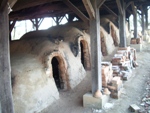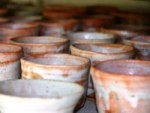The elements of Japanese Ceramics
Long history, pottery towns existing nationwide, variety kinds of glaze, highly honed techniques and cross-fertilizations with other Japanese traditional cultures such as tea ceremony, flower arrangements, and foods- These are pieces of Japanese ceramics.

The oldest Japanese ceramics is an earthenware called Jomon-ware, and has a long history of approximately 12,000 years. Starting from such ancient time, there occurred a lot of historical influence and cultural development on Japanese ceramics, and finally came to be as it is today.
Japan has more than 50 pottery towns nationwide, from Mashiko to Arita, and each pottery town has its own history and cultural background. These essences of each location have fostered ceramics having particular characteristics rooted in each place.

In regards to the variation of glazes, Japanese ceramics has immense kinds of glazes including Shino, possibly a most popular glaze, Oribe and a lot more, leading into beautiful colors of pottery.
Seeing such fine and sensitive painting techniques of Arita, for example, we feel astonished and see the highly advanced and improved the skills that Japanese ceramic artists have. In addition to Arita, the rusticity existing behind Yakishime is the achievement of nicety and beauty.
These elements mentioned above are stirred and formed into Japanese ceramics today. Japanese people use pottery teapot as a tea ceremony tradition, and cut flowers in pottery vase when they appreciate flower arranging.
Ceramics is surely a traditional culture for Japanese people, but still deeply embedded as a part of culture living today. With deeper understanding of each element, you will savor the lure and beauty of Japanese ceramics. Come and stay in Japan, the authentic country of ceramics.
Feel the fresh air, communicate with local people, and put yourself in totally new circumstances!
Enormous inspiration will surely come up to you.
Now start Explore Japanese Ceramics!
